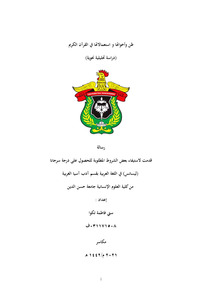Fatimah T.E.K.U.A, ST. (2021) ZHONNA WA AKHWATUHA WA ISTI’MALATUHA FI AL-QUR,AN AL-KARIM (DIRASAH TAHLILIYYAH NAHWIYYAH). Skripsi thesis, Universitas Hasanuddin.
![[thumbnail of Cover]](/11419/1.hassmallThumbnailVersion/F031171508_skripsi_19-10-2021%20cover1.png)

F031171508_skripsi_19-10-2021 cover1.png
Download (134kB) | Preview
F031171508_skripsi_19-10-2021 1-2.pdf
Download (1MB)
F031171508_skripsi_19-10-2021 dp.pdf
Download (645kB)
F031171508_skripsi_19-10-2021.pdf
Restricted to Repository staff only
Download (1MB)
Abstract (Abstrak)
In this study, the research discussed about "Dzonna Wa Akhwatuha" which is one of the 'amil nawasikh lil mubtada' khobar (the destructive factor for mubtada' khobar) in the form of verbs. Dzonna wa akhwatuha goes into a nominal sentence and makes mubtada' as the first object for it and makes khobar as the second object for it, and the sentence is complete because it is equivalent to the subject that recites (nashab) two objects at once derived from mubtada' and khobar (nominal sentence).
In this study, the researcher focused on three Surahs, they are Surah An-Nisa' and Al-Ma'idah and Al-An'am because in these three surahs, there are many sentences that contain dzonna wa akhwatuha, which are as many as 80 data. The problem formula in this study are (1) What verses are contained in dzonna wa akhawātuhā in Surah An-Nisa' and Al-Ma'idah and Al-An'am? (2) How is the use of dzonna wa akhawātuhā in Surat An-Nisa' and Al-Ma'idah and Al-An'am? The
purpose of this study are (1) To describe dzonna wa akhawātuhā in Surah An-Nisa' and Al-Ma'idah and Al-An'am (2) To analyze the use of dzonna wa akhawātuhā in Surah An-Nisa' and Al-Ma'idah and Al-An'am.
This research is qualitative research with the design of literature study research. The data is in the form of dzonna wa akhawātuhā, and the source of data is Al-Qur'an, Surah An-Nisa' and Al-Ma'idah and Al'-An'am. Technique of data collection that used is documentation methods.
Overall, the results of the dzonna wa akhawātuhā study contained in Surah An-Nisa', Al-Māidah and Al-An'am amounted to 80 data that analyzed based on: 1) I'mal (functioning), as many as 66 data that consist of 21 data in Surah An-Nisa', and 23 data in Surah Al-Ma'idah, and 22 data in Surah Al-An'am. 2) Ta'liq (invalidated), as many as 2 data, that is in verse 71 in Surah Al-Ma'idah is ta'liq because it was preceded by "lam nafiyah", and in verse 33 in Surah Al-An'am ista'liq because it was preceded by “lam ibtida”. 3) Mahdzuf (discarded), as many as 12 data dzonna wa akhwatuha which one of the object or both discarded that is 3 data dzonna wa akhwatuha contained in Surah An-Nisa' and 2 data contained in Surah Al'An'am, and 7 data contained in Surah Al-An'am.
Keywords : Qur'an, Syntax , Dzonna Wa Akhawātuhā
| Item Type: | Thesis (Skripsi) |
|---|---|
| Subjects: | P Language and Literature > PQ Romance literatures |
| Depositing User: | S.Sos Rasman - |
| Date Deposited: | 26 Nov 2021 07:09 |
| Last Modified: | 26 Nov 2021 07:09 |
| URI: | http://repository.unhas.ac.id:443/id/eprint/11419 |


